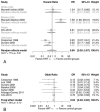Hormone Replacement Therapy in Endometrial Cancer Survivors: A Meta-Analysis
- PMID: 34300331
- PMCID: PMC8303659
- DOI: 10.3390/jcm10143165
Hormone Replacement Therapy in Endometrial Cancer Survivors: A Meta-Analysis
Abstract
The purpose of this study is to investigate the effect of hormone therapy (HT) on the oncological outcomes of endometrial cancer (EC) survivors. A systematic literature review was conducted in July 2021 to identify studies detailing the effect size for the relationship between HT use in EC and oncological outcomes (survival and disease recurrence). This included studies that evaluated the different recurrence rates among women treated for EC who subsequently underwent HT and those who did not. The collected studies were evaluated for quality, heterogeneity, and publication bias, and a pooled odds ratio (OR) or hazard ratio (HR) was calculated with a confidence interval of 95% (95% CI). In total, 5291 studies were collated, and after the review process, one randomized trial and seven observational studies were included, comprising 1801 EC survivors treated with HT and 6015 controls. The time-dependent analysis could be conducted for four studies, and considering the disease-free survival, the pooled HR of 0.90 (95% CI 0.28 to 2.87) showed no significant differences. However, among Black American women treated with continuous estrogen HT, the HR was 7.58 (95% CI 1.96 to 29.31), showing a significantly increased risk of recurrence for women in this ethnic group. Considering the pooled OR of all included studies 0.63 (95% CI 0.48 to 0.83), a significantly reduced risk of recurrence was found among EC survivors treated with HT. Considering the type of HT, the most risk-reducing was combined estrogen and progestin therapy and the cyclic regimen. Although supporting evidence is based mainly upon observational studies, evidence of no increased risk or even decreased risk was generally found, apart from in Black American women where a significantly increased recurrence risk was evident. The data are rather reassuring for the short-term administration of HT to symptomatic EC survivors. Future studies with a longer follow-up are necessary to better clarify the long-term effects of HT.
Keywords: disease free survival; endometrial cancer; estrogens; ethnic origin; hormone replacement therapy; hormone therapy; overall survival; progestins; recurrence.
Conflict of interest statement
The authors declare no conflict of interest.
Figures




References
-
- Londero A.P., Bertozzi S., Cedolini C. Cancer Etiology, Diagnosis and Treatments. Nova Medicine & Health; New York, NY, USA: 2019. The Sentinel Lymph Node: Detection, Procedures and Clinical Implications.
-
- Daraï E., Gompel A., Deval B., LaPlace C., Lemoine A., Labeyrie E., Neu A.M., Poitout P. Hormone replacement therapy after endometrial or ovarian cancer. Gynécologie Obs. Fertil. 2000;28:198–204. - PubMed
Publication types
LinkOut - more resources
Full Text Sources

